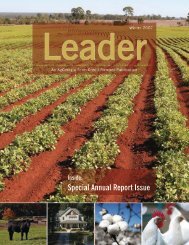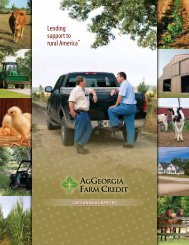Meet AgGeorgia Member Kabe Cain Game Changers and the 2013 ...
Meet AgGeorgia Member Kabe Cain Game Changers and the 2013 ...
Meet AgGeorgia Member Kabe Cain Game Changers and the 2013 ...
You also want an ePaper? Increase the reach of your titles
YUMPU automatically turns print PDFs into web optimized ePapers that Google loves.
Quitman-Brooks County Chamber of<br />
Commerce Plantation Dinner Salutes<br />
Locally Grown Movement<br />
Suppressing Invasive Pigweed<br />
By Jackie Busby, Soil Conservationist, Hawkinsville<br />
Martin shows how rolled<br />
rye is helping his peanuts.<br />
The Henry Gray Turner house in Quitman<br />
was <strong>the</strong> site of <strong>the</strong> Quitman-Brooks County<br />
Chamber of Commerce Plantation Dinner<br />
fundraiser this past November. As a salute<br />
to <strong>the</strong> “locally grown” movement, which<br />
encourages people to eat locally produced food,<br />
<strong>the</strong> dinner featured menu items produced in<br />
Brooks County.<br />
The menu included mixed green salad,<br />
pork loin, seasonal vegetables <strong>and</strong> pecan<br />
pie. “We are very fortunate here in Brooks<br />
County to be home to some of <strong>the</strong> highestquality<br />
agricultural producers in <strong>the</strong> state<br />
of Georgia,” said Lauren Basford, president<br />
of <strong>the</strong> Quitman-Brooks County Chamber<br />
of Commerce <strong>and</strong> assistant director of <strong>the</strong><br />
Brooks County Development Authority.<br />
“Several have even become nationally recognized.<br />
The menu for <strong>the</strong> event was comprised<br />
entirely of Brooks County products <strong>and</strong><br />
featured over a dozen of those farms.”<br />
Farms that provided <strong>the</strong> dinner items<br />
included DeWitt Farms <strong>and</strong> Exum Pecan<br />
Company in Morven; Dixie Bee Company,<br />
Dixie Hay Farm <strong>and</strong> Thompson Farms Smokehouse<br />
in Dixie; Dreaming Cow Creamery,<br />
Green Hill Dairy <strong>and</strong> Tim Crosby Farms in<br />
Pavo; <strong>and</strong> Edwin Pope Farms <strong>and</strong> Sam Martin<br />
Farms in Barwick.<br />
The plantation dinner was <strong>the</strong> last<br />
major event of <strong>the</strong> year that Corey Cottle, <strong>the</strong><br />
Chamber’s 2012 chairman, was responsible for<br />
planning. Cottle, who is <strong>the</strong> branch manager<br />
“ ... we recognize <strong>the</strong><br />
importance of agriculture<br />
as <strong>the</strong> largest employer<br />
<strong>and</strong> major revenue<br />
generator for Brooks<br />
County.”<br />
~ Corey Cottle<br />
“We are very fortunate<br />
here in Brooks County<br />
to be home to some<br />
of <strong>the</strong> highest-quality<br />
agricultural producers in<br />
<strong>the</strong> state of Georgia.”<br />
~ Lauren Basford<br />
in <strong>the</strong> Quitman office of <strong>AgGeorgia</strong> Farm<br />
Credit, saw <strong>the</strong> inaugural event as an opportunity<br />
to involve <strong>the</strong> agricultural businesses<br />
of <strong>the</strong> county <strong>and</strong> spotlight <strong>the</strong>ir importance<br />
on <strong>the</strong> local economy. “Many times Chambers<br />
of Commerce don’t do a great job of reaching<br />
out to local farms <strong>and</strong> ag businesses, if for no<br />
o<strong>the</strong>r reason than that <strong>the</strong>y might not be as<br />
visible as a retail operation with a downtown<br />
storefront,” he said. “However, we recognize<br />
<strong>the</strong> importance of agriculture as <strong>the</strong> largest<br />
employer <strong>and</strong> major revenue generator for<br />
Brooks County.” z<br />
The Henry Gray Turner house was <strong>the</strong> site<br />
of <strong>the</strong> Quitman-Brooks County Chamber of<br />
Commerce Plantation Dinner.<br />
Photo by Jared Renfroe<br />
The menu for <strong>the</strong> event featured food produced in Brooks County. Photo by Alissa Shore<br />
Christopher Martin stood gazing across <strong>the</strong><br />
large field of green, head high rye, thinking<br />
“What have I gotten myself into this time?”<br />
“Will my equipment get through this much<br />
rye?” “Can I get a good st<strong>and</strong> of cotton<br />
planting in rolled straw?” “Will this rye mat<br />
hold <strong>the</strong> pigweed back <strong>and</strong> give me <strong>the</strong> weed<br />
control I’ve been looking for?”<br />
The current scourge of cotton production<br />
in Georgia <strong>and</strong> <strong>the</strong> sou<strong>the</strong>ast is an herbicide<br />
resistant pigweed, which is known as Palmer<br />
Amaranth. This high-seed producing plant<br />
is rapidly increasing its territory despite<br />
herbicide applications. Previous weed<br />
wars made it obvious to Martin that new<br />
or additional weapons would be needed to<br />
take on this mutated pigweed.<br />
Research conducted by Stanley<br />
Culpepper, extension agronomist, specializing<br />
in weed science <strong>and</strong> o<strong>the</strong>rs, proved that<br />
rolling down rye into a thick mat to block out<br />
sunlight is highly effective in <strong>the</strong> reduction<br />
of pigweed seed germination in crop fields.<br />
Research also indicates that allowing <strong>the</strong><br />
Cotton with pigweed<br />
“I am increasing <strong>the</strong><br />
acreage I am<br />
planting using <strong>the</strong> rolled<br />
rye technique.”<br />
~ Christopher Martin<br />
cover crop to mature until it blooms gives<br />
<strong>the</strong> best results by providing an extended<br />
period of soil shading.<br />
Rye was chosen as <strong>the</strong> cover crop due to<br />
its chemical properties which discourages <strong>the</strong><br />
“germination” <strong>and</strong> “growth” of o<strong>the</strong>r plants.<br />
Establishing a thick, tall, rye cover crop on<br />
Martin’s farm was step one in this pigweed<br />
war. High seeding rates, early planting date,<br />
<strong>and</strong>/or fertilization can be used to obtain <strong>the</strong><br />
desired high volume of rye cover. “I had tried<br />
rye cover crops <strong>and</strong> strip tilling before,” said<br />
Martin. “However, having this much rye,<br />
rolling <strong>the</strong> cover crop, <strong>and</strong> planting into a<br />
six inch strip, was new for me.”<br />
The second step in <strong>the</strong> battle for control<br />
of Martin’s cotton <strong>and</strong> peanut fields was to<br />
roll <strong>the</strong> rye cover down in <strong>the</strong> same direction<br />
as <strong>the</strong> following crop will be planted. Martin,<br />
along with o<strong>the</strong>r producers in <strong>the</strong> pilot project<br />
area, developed a heavy steel pipe roller 21 feet<br />
long to roll down <strong>and</strong> compress <strong>the</strong> green rye<br />
plants. The heavy roller worked like a charm.<br />
It forced <strong>the</strong> mature but still green rye into a<br />
soil shading mat—very little of <strong>the</strong> rye stood<br />
back up. After rolling <strong>the</strong> rye, a herbicide was<br />
applied to kill <strong>the</strong> rye.<br />
Finally, Martin planted cotton seed into<br />
six-inch strips. This required some adjustments<br />
to his strip-till planter. During prior<br />
years, Martin planted into one-foot strips.<br />
The goal is to disturb no more soil than<br />
necessary to get good soil seed contact. In<br />
addition, leave <strong>the</strong> rolled rye undisturbed to<br />
shade all areas except directly above <strong>the</strong> crop.<br />
This planting resulted in an excellent st<strong>and</strong><br />
of cotton, devoid of pigweed plants. Along<br />
with post planting applications of herbicides,<br />
<strong>the</strong> thick rye cover crop resulted in excellent<br />
suppression of <strong>the</strong> pigweed <strong>and</strong> o<strong>the</strong>r yield<br />
robbing weeds.<br />
The rye cover deteriorated slowly <strong>and</strong><br />
helped maintain exclusion of sunlight until<br />
<strong>the</strong> cotton was able to shade <strong>the</strong> soil surface<br />
<strong>and</strong> impede germination of weed seeds. Time<br />
was just what Martin needed, time to allow<br />
<strong>the</strong> planting of <strong>the</strong> crop into a weed-free<br />
environment, time for <strong>the</strong> seed to germinate,<br />
<strong>and</strong> time for <strong>the</strong> seedling to grow into a crop<br />
big enough to shade <strong>the</strong> ground for itself.<br />
Martin remarked, “I had my doubts when<br />
we started. Now after <strong>the</strong> second season of<br />
planting into a rolled rye cover crop, I am sold<br />
on <strong>the</strong> practice. I am increasing <strong>the</strong> acreage I<br />
am planting using <strong>the</strong> rolled rye technique.”<br />
Continued on Next Page<br />
<strong>AgGeorgia</strong>.6.Winter <strong>2013</strong><br />
<strong>AgGeorgia</strong>.7.Winter <strong>2013</strong>










